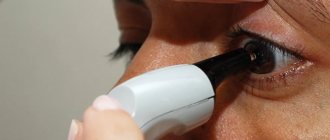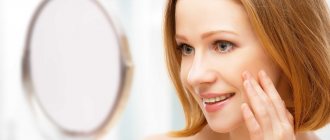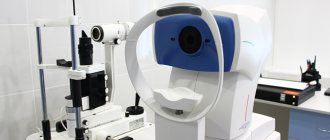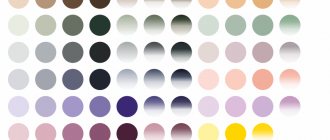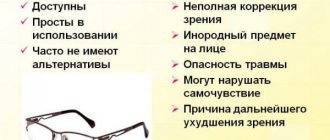There are a number of diseases associated with ophthalmology - astigmatism, hyperopia (farsightedness), myopia (nearsightedness) and others. When diagnosing them, you may need to wear glasses. People over 40 develop age-related presbyopia, which requires ophthalmological assistance to improve the clarity of the visible image when reading or watching TV. In certain cases, constant wearing of optical products is prescribed.
It is recommended to undergo an examination every year, even when your vision is good and there are no complaints.
In what cases are glasses worn?
The decision about the need to wear glasses is made by the doctor, based on indicators obtained using certain diagnostic methods. You should think about corrective measures in the following cases:
- you have to squint;
- at night vision deteriorates;
- letters and numbers blur when reading;
- with prolonged stress, a headache occurs in the forehead.
Glasses are prescribed to persons with refractive errors - myopia, hypermetropia, astigmatism. For myopia, it should be worn when watching TV and reading, if the visual acuity is -0.75 and up to -3 diopters. If the indicator is higher, the optics are used constantly.
Sharpness at -6.0 diopters is restored to its maximum. If the degree of refractive error is higher, two pairs of vision correction devices or surgery will be required.
Farsightedness is focusing behind the retina of the lens. Glasses are prescribed for readings of +0.75 diopters. Prescribed for temporary wearing if objects lose their contour close up and there are no other ophthalmological problems.
For hypermetropia, glasses are selected according to the degree of visual impairment. The distance from the eyes to the glass should be 1.2 cm. When choosing, it is important to take into account not just the indications after a comprehensive diagnosis of the optical system, but also the patient’s lifestyle, type of activity and other factors.
With myopic and hypermetropic astigmatism, an irregular shape of the lens or cornea is observed. Correction is carried out with toric lenses or cylindrical glasses. For complex defects, toric glasses with correction along 2 meridians are used.
Wearing it is also recommended for aniseikonia - an abnormal structure of the eyeballs, and for heterophoria - hidden strabismus.
Constant wearing of vision correction devices is required only in situations where the patient cannot see without them. Otherwise, a violation of accommodation occurs, due to which visual perception becomes unclear and requires constant wearing of glasses.
Are they needed constantly?
It is advisable to do visual gymnastics daily.
With regular use of glasses, a problem such as accommodation disorder may arise - difficulty focusing vision on an image, causing it to become blurry.
For normal work, it is recommended to do visual gymnastics; for the expected load, it is important to wear glasses. The correct selection of an optical device will help stop the loss of vision. But the need for constant wearing can only be decided by a doctor. Be sure to select glasses or contact lenses for myopia minus 3. In this case, they can be worn constantly. However, it is important to undergo preventive examinations with an ophthalmologist once every year or six months to correct diopters. Also, people over 40 with farsightedness need optical reading devices. The decision about the need for glasses correction for children can only be made by a doctor.
Diagnostics
To identify refractive errors and other diseases of the visual organs, a comprehensive examination will be required at an ophthalmological clinic, a private center or a municipal institution. A series of tests are carried out, after which the doctor assesses the condition of the visual analyzer and gives the patient a conclusion indicating the diagnosis and the degree of visual impairment.
Visometry
The main way to determine the acuity of visual perception is carried out using special tables. For adults, use Sivtsev’s table, and for children, Orlova’s.
This technique is indispensable in ophthalmology and allows you to accurately determine what disorder is present in the patient. The procedure is non-invasive. If the patient wears glasses, it is carried out twice - without them to determine the relative acuity and with them to determine the absolute acuity.
Sivtsev's table contains Cyrillic characters, the size of which decreases with each subsequent line. 100% vision - the ability to recognize letters from line 10 at a distance of 5 meters. The table should be well lit and located close to the window.
If the patient cannot see from the 7th row of the Sivtsev table, lens selection is required.
Visometry is performed for children with the recognition of animals, the figures of which gradually become smaller. The Aleynikova table is most often used, especially for children aged 3-6 years.
The acuity of visual perception depends on the width of the pupil, the transparency of the cornea, the condition of the lens and the optic nerve.
Clinical refraction
Refraction refers to the process of refraction of light rays in the optical medium of the eyeball. To find out the dioptric system of the visual analyzer, you will need to determine the refractive indices of the aqueous humor and lens, the radius of curvature of the cornea, the thickness of the biconvex lens and the depth of the anterior chamber.
Method for checking clinical refraction:
- Atropine is instilled into the patient
- A person sits in front of the device and fixes his head. She can't move.
- The device produces images that constantly change sharpness. At this time, the necessary indicators are recorded automatically and manually.
In the presence of myopia and hypermetropia, plus or minus glasses are used. The doctor changes the optical power of the glasses until he determines the optimal visual acuity of the patient.
Cross-cover test and Maddox study
This is a limitation of binocular vision with observation of the movement of the eyeballs. The test is performed for hidden strabismus.
How to do it:
- Close your right eye with your hand.
- With your left, look closely at any object. Both eyes remain open during the examination.
- The right organ of vision opens. If the eye begins to move towards the nose to focus the naked vision, a diagnosis of convergent strabismus is made. If a previously closed organ moves away from the nose, it is a divergent strabismus.
Maddox's study is being conducted to study binocular vision and retinal health in cataracts. Diagnostics determines the signs of strabismus and the state of phoria.
Method:
- the patient fixes a point light source with a diameter of 10 m;
- examines from a distance of 5 m through a trial frame with lenses;
- a red Maddox cylinder is inserted into one socket;
- if the strip coincides with the lamp, the diagnosis is orthophoria; if it does not coincide, heterophoria is diagnosed.
If the deviation is minor, no treatment is required.
Anizeikonometer
The device is used to determine the degree of aniseikonia. The diagnostic procedure is based on the presentation of tests (lines, figures and bodies), one part of which is visible only to the left and the other to the right visual organ.
The degree of violation is determined as a percentage. If it is 2%, it does not cause severe discomfort; if it is 2.5% or higher, treatment is necessary to correct the size of the image on the retina. Therapy consists of selecting special glasses.
If the degree of impairment is 10%, the use of spectacle correction is ineffective. In severe cases of the disease, when the violation is more than 30%, corrective measures will not help.
Myopia
Myopia or myopia is a pathology in which the patient has difficulty distinguishing objects located in the distance. At the same time, he clearly sees what is next to him and, when approaching, can read without glasses.
Translated from Greek, the term myops means “squinting eye.” The disease myopia received its name because people with myopia constantly squint in order to shift the main focus at least temporarily and look at distant objects.
Causes and degrees of pathology
In a healthy eye, the optical media (lens and cornea) evenly refract light rays, so that the latter fall directly on the retina. In the presence of myopia, this refraction occurs much more strongly. Thus, light rays are focused in front of the retina and create the effect of blurring distant objects.
There are two types of myopia:
- congenital;
- acquired.
In the first case, the cause of the disease is improper formation of the eyeball during intrauterine development of the fetus. A child is born with this pathology, and the disease may progress in the future.
Do I need reading glasses?
Reading glasses are:
- ordinary;
- with increased visibility.
An ophthalmologist can prescribe the following types of correction agents:
- bifocal;
- office;
- progressive.
The selection of suitable glasses is carried out by an optometrist. With the help of correction means, a person will not only get rid of migraines and discomfort caused by eye fatigue, but will also be able to better understand text.
Farsightedness
Farsightedness (hyperopia) is a visual impairment in which light rays are refracted through the lens and focused not on the retina of the eyeball, but behind it. As a result, the patient may have difficulty distinguishing both near and distant objects.
With minimal deviations this may go unnoticed. The fact is that slight farsightedness is compensated by the ability of the human eye to focus at different distances. When viewing nearby objects, the accommodative muscle tenses, resulting in increased refractive power of the eye.
Most children are born farsighted because the eyeball is still small and undeveloped. Hypermetropia can persist for up to 7 years, and sometimes longer. For minor deviations, no correction is required. Annual observation by a doctor and compliance with specialist recommendations is sufficient.
As the child grows, the eyeball develops and increases in size, so vision returns to normal. But this does not happen for everyone. If the disturbances persist, accommodation will no longer help, but will only worsen the problem. Pathologies such as amblyopia and strabismus may occur.
Wearing glasses can be prescribed by a doctor for farsightedness of +0.75 diopters or more. If the patient has difficulty distinguishing only objects that are nearby, wearing glasses can be temporary: when reading, writing, working at a computer, watching TV, driving, etc. Vision correction will help a person to freely navigate the surrounding space and reduce the risk of complications.
For hypermetropia of the second and third degree, children and adults are recommended to constantly wear glasses. Otherwise, due to regular eye strain, you may experience a feeling of fatigue, headaches and further deterioration of vision.
The decision to prescribe glasses for permanent or temporary wearing is made by the doctor individually for each patient.
Does a child with farsightedness need to wear glasses all the time?
Farsightedness, as a pathology, is less common than myopia. At the same time, all people are born farsighted. As the eyeballs grow, this defect disappears. The reserve of farsightedness in a child is approximately +4-5 diopters. By the age of 6-7 years it does not exceed 1.5-2 diopters, and by the age of 10 the eyeballs practically stop growing. As a result, vision stabilizes.
If, as the child grows, the eye condition does not improve, hypermetropia is diagnosed. The cause of the pathology may be a genetic predisposition. Also, farsightedness is often caused by injury to the eyeballs or orbit, an inflammatory eye disease, or eye surgery, which leads to curvature of the shape of the cornea or lens.
With hypermetropia, a person has good distance vision. Near vision may be poor. But in childhood, this defect is overcome by the accommodative apparatus - the ability of the lens to change its curvature and refractive power. Typically, children with low farsightedness do not need to wear glasses. But it also depends on the degree of refractive error.
Change your glasses at night
This advice is relevant for drivers who may wear the same sunglasses day and night. During the day - to protect your eyes from bright sun rays, and at night - so as not to be blinded by the light of lanterns and headlights of oncoming cars. However, this approach is wrong; ordinary sunglasses are not intended for night driving; they darken the image too much, which can lead to an accident. For night driving, you should purchase special glasses with yellow lenses, which increase contrast and improve visibility thanks to anti-headlight coating.


